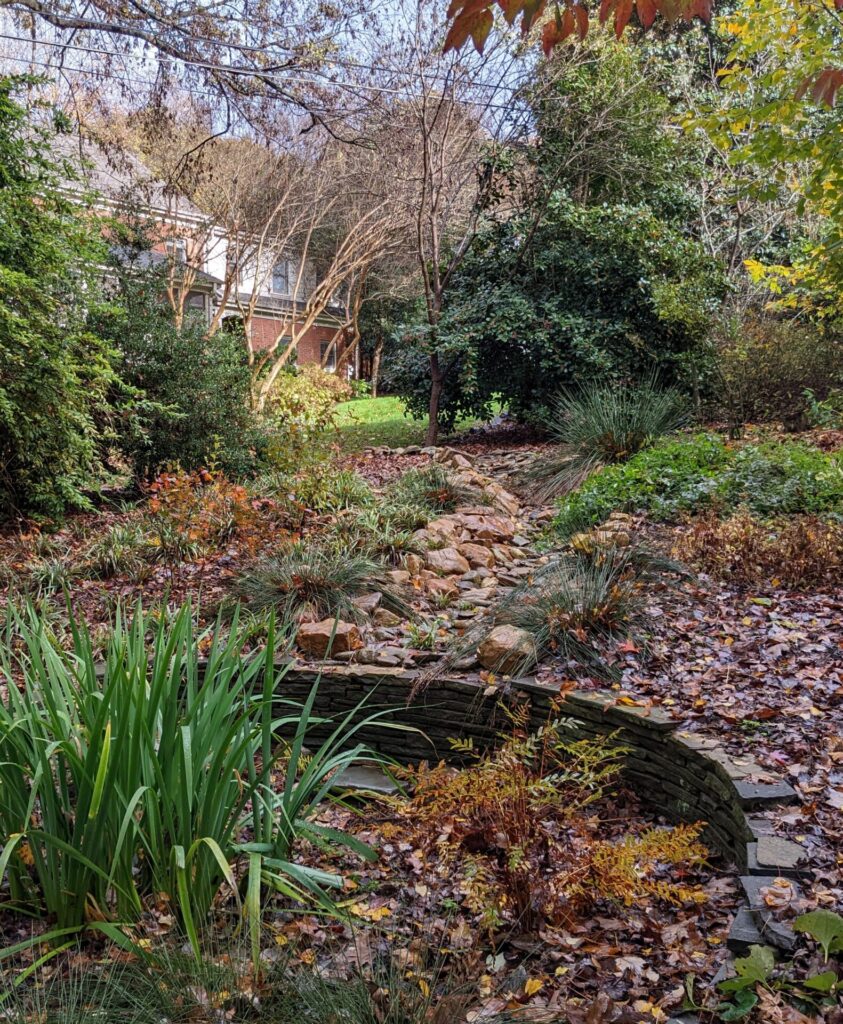Photos and text by Paula Gross reporting for Native Plant News
Water is life. All habitats and gardens need it. At the same time, water is becoming an even more powerful force to be reckoned with on our changing planet. As plants-people, we watch forecasts and measure rainfall, making sure the plants in our care are getting what they need to thrive. But if you live in a city or dense suburb, the clap of thunder and woosh of rushing water through gutter pipes are not always comforting sounds. Fueled in speed and volume by the sheer amount of impermeable surfaces in our midst, water in the urban/suburban garden can rapidly shape-shift from plant nourisher to destroyer of landscape. Think “too much, too quickly”–and you get the picture. Heavy rain flowing off roofs, roads, sidewalks, and parking lots and into our yards can equal scouring and eroding of land, or even flooding from nearby creeks and streams, as all that water seeks the low ground. I have a flat property, and still, I deal with pools of standing water in compacted soil.
We’ve heard the call of ecological gardening. We are creating gardens with native plants front and center–for our own pleasure as we connect with their beauty and our natural heritage, but also to be part of a network of nourishing habitats for birds, pollinators, and many unseen creatures. What we may not have anticipated is just how challenging (if not destructive) dealing with excess water in our gardens can be. Under pressure, it’s tempting to take a “me against the water” mindset. But if we pause, and shift into the perspective that we are fully a part of the web of life with interconnectedness in mind, it’s possible to find new solutions.
It’s possible to step into empowered stewardship of our gardens and land. I know of no better witness to this than Charlotte gardener Carla Vitez. Presented with a perfect storm of water issues, she has combined a deep respect for native plants, a stewardship mindset, and hopeful persistence to create an oasis of life and beauty–and a determination to share it.
Carla has been a gardener at heart, from her childhood in south Georgia to her days as a botany student under the mentorship of Dr. Janice Coffey Swab, and is now a passionate gardener. She began, in earnest, tackling her “wrecked out with invasives” one-acre garden over 25 years ago. Skip forward to last fall when she hosted a North Carolina Native Plant Society tour of the property, sharing a garden that is not only beautiful but is a living example of techniques and strategies for dealing with the powerful force of urban water flow. As examples go, it doesn’t get much more dramatic.
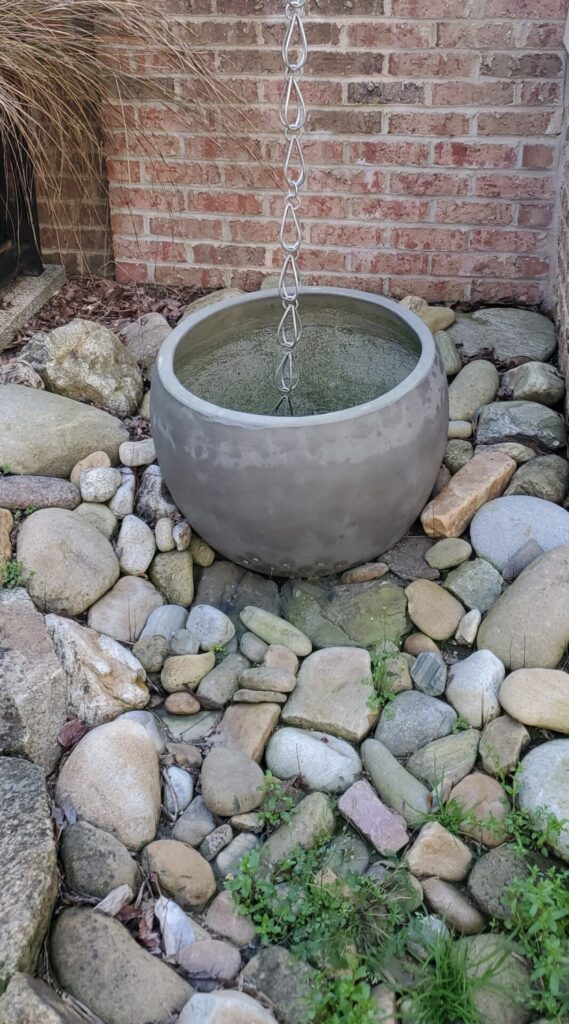
Dealing with stormwater challenges
When asked to describe her stormwater challenges, she pauses for a moment, and says, “It’s Geography!” She continues. “My property is sloped and it is unique in that I have eight next door neighbors. Eight properties touch mine and my back yard is at the lowest spot. I have a creek running on the side and back of my property, and all of my many neighbors’ stormwater drains through my yard.”
Carla’s site definitely had stormwater challenges. All that water, often concentrated through the indiscriminate use of black plastic piping, came roaring through and was creating increasingly eroding ruts. Then it hit the creek, already loaded from stormwater upstream, and it was completely tearing out the banks.
“It was not something I could ignore–it was just, how do I deal with this?”
As a lover of books and learning, she began by reading everything she could find. She soon realized that what was happening in her backyard was happening to streams all over Charlotte. She became curious about stream restoration projects, began going to city meetings and connecting with the people involved, and saw the damage happening to the stream behind her children’s school. Her curiosity and connections led her to understand the problem was about much more than aesthetics. It was about water quality. All the runoff from surfaces picks up pesticides, oils, chemicals, and sediment as it moves across them. Whether the water goes into a storm drain or directly into a creek, it all ultimately ends up unfiltered and untreated in the waterways. Water and how and where it moves impacts far more than a backyard. Water connects us: plant to animal, ocean to ocean, and neighbor to neighbor.
“I wanted to be an example.”
Carla began experimenting with landscaping techniques she was hearing about through projects across Charlotte. When she learned about a new Urban Cost Share Grant being offered through the Mecklenburg County Soil and Water Conservation District, she applied and got the grant. That helped pay for revegetating her eroded streambank. This spurred her to apply again and install her first rain garden. Things are always evolving, and she has evolved with them. It’s taken time, but her garden is practically a one-stop showcase for dealing with stormwater in a sloped landscape.
She has put in dry stream beds and swales, several rain gardens, coir logs and live staking along the creek, tree trimmings in parallel rows to slow water, and used rain barrels and rain chains for water coming off her roof. And it’s working. After a recent major rain event, her ground held, even as reports of blow-outs came from other gardeners and stream sites. She’s learned over time that “seeing is better than saying.” Carla said, “I wanted to be an example that others could really learn from.” She has learned that there is no one solution to slowing the flow of water coming in and stopping erosion, but that is where to begin. The next step is to explore techniques that encourage the water to infiltrate the soil it passes over, allowing soil and plants to filter out toxins, and to prevent stream-life choking sediments from overloading creeks.
Three Techniques to Slow EROSION
Constructing Dry Streambeds
The goal of a dry streambed is to provide a designated pathway for water leaving a roof or road or patio, so that flow is predictable and shielded from bare soil. Ultimately, the goal is to get slowed water into contact with plants, so dry streambeds are just a piece of that. Finer rock or recycled concrete is used as a base layer. No fabric is used underneath. Carla has learned it can impede water infiltration, and (counterintuitively) ends up encouraging weeds. Larger rocks are used to cover the fine base and line the bed, so that water can both infiltrate down and move with some force over the rock without scouring away earth. Using plants on the edges of dry creek beds, rather than in them, allows both flow and some uptake. Some of Carla’s favorite plants along dry beds are Soft Rush (Juncus effusus), Blue Flag Iris (Iris versicolor), and Swamp Rose (Rosa palustris). She has used River Oats (Chasmanthium latifolium), as well, but calls them “a tiger in the garden”–beautiful, but overly vigorous, so approach with caution. Use only in wilder areas, keeping them out of cultivated beds.
Reusing brush and debris to form terraces
After a neighbor lost a large creekside tree (likely due to being undercut by the erosion caused by unmanaged stormwater), Carla used the cut pieces and brush to create neat rows of the debris, with the goals of slowing the flow of water towards the creek and building soil. Eventually this material breaks down and feeds other trees and plants whose roots are filtering stormwater and holding soil. This is something anyone can accomplish–no materials cost, just some sessions of gardening crossfit required.
Filtering and slowing stormwater flow with rain gardens
Rain gardens may be the poster children of ecological stormwater management, but they are not for every situation. It’s not that the concept is flawed, it’s more about fine-tuning to the site, managing expectations, and understanding they require maintenance, like any garden. Rain gardens are areas built slightly sunken and are filled with very well-draining soil mixes. The plants chosen for a rain garden must be able to withstand both periods of flooding and periods of drought. After a storm event, a rain garden “fills up” and it may take a couple days for water to fully sink into the surrounding earth. If rains are far apart, this same garden can become quite dry (due to the well-draining soil mix).
Carla has had success with small rain gardens she built herself as well as larger ones that required professional help. She’s learned when it comes to plant selection to go for fewer species, rather than trying one of everything. Appearance matters and by selecting just 3-5 species and clustering them, the garden pleases your (and your neighbors’) eyes, as well as serving its stormwater and habitat benefits.
For a small rain garden, you may choose just grasses and perennials; larger ones could be anchored with a tree or two and swaths of shrubs. Consider that the rain garden is an ornamental bed like others (just with secret superpowers), so when choosing from rain garden plant lists, consider seasonality and use basic design principles. One of Carla’s favorite resources is Rain Gardening in the South by Helen Kraus and Anne Spafford. It is clear, simple, and encouraging. One caveat – the authors do include some known invasives in their plant lists at the end of the book, so always cross reference against regional invasives lists before making plant selections. Other good sources of information include the Carolina Rain Garden Initiative by the SC Cooperative Extension Service. They even have a Master Rain Gardener program. The NC Cooperative Extension has a variety of rain garden resources, as well.
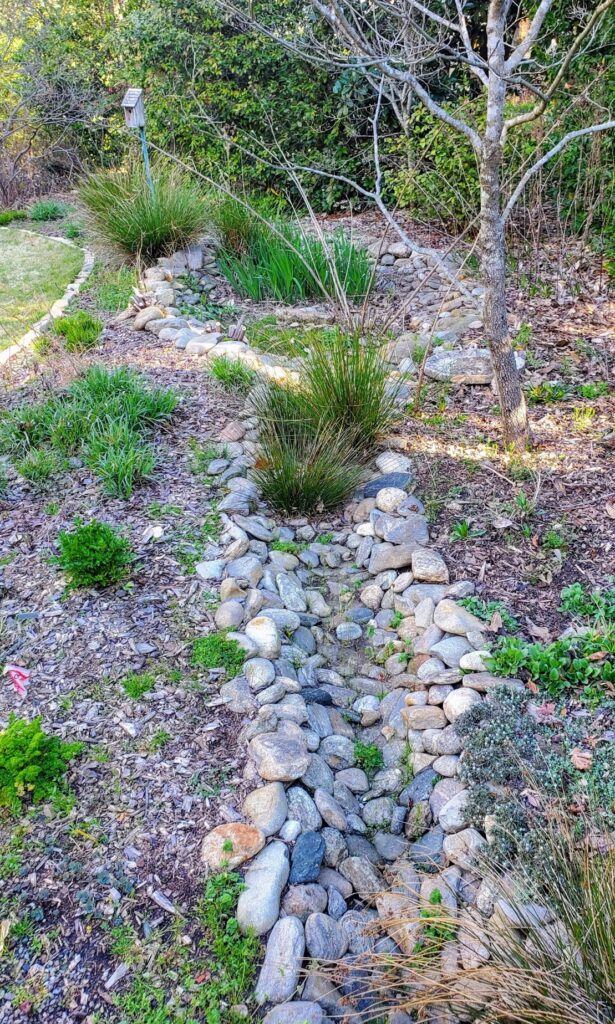
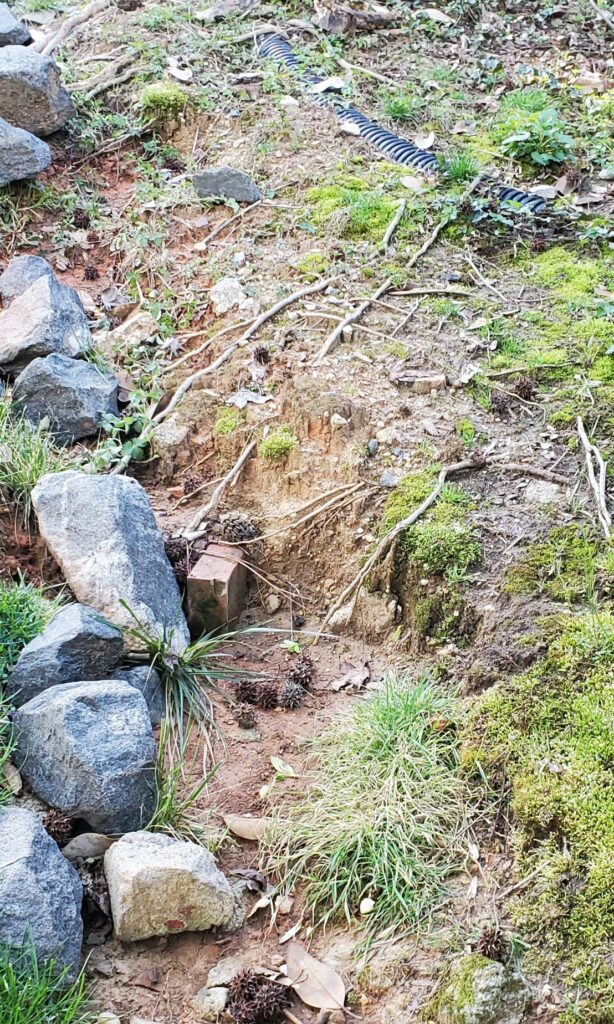
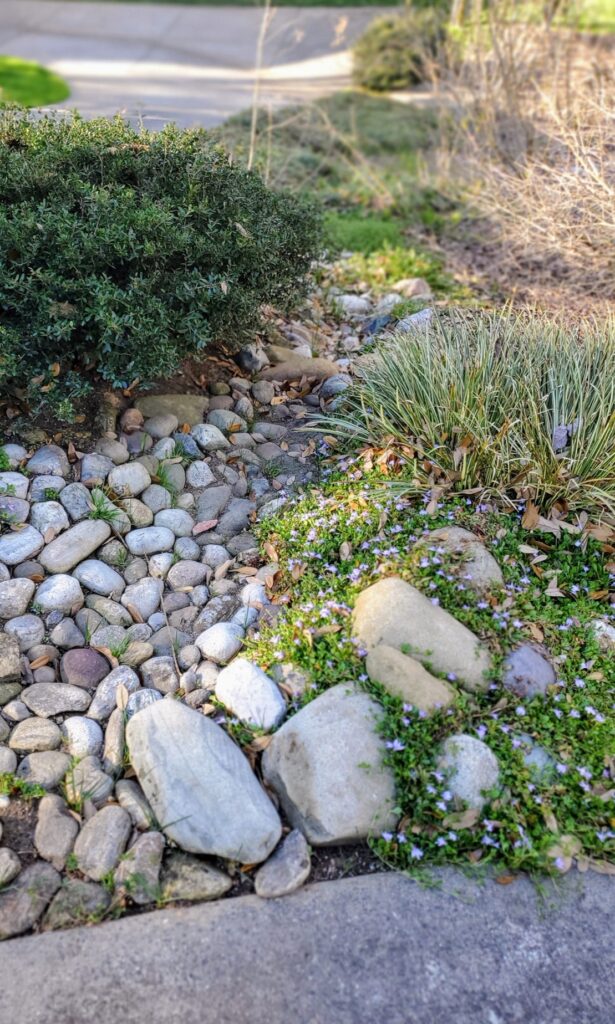
Even if a rain garden is not needed, if you are dealing with a low spot in the yard that doesn’t drain after a rain you can look to the lists of rain garden plants. Back in the early 2000s, botanists Jim Matthews and Larry Mellichamp created a list of native plant candidates for rain gardens, based on their combined knowledge of wetland or wetland-adjacent habitats. Many of their suggestions have become staples. Here are some of my own favorite species for sunny rain gardens. Trees: Pond Cypress (Taxodium ascendens), Sweet Bay (Magnolia virginiana); Shrubs: Common Winterberry (Ilex verticillata), Sweet Pepperbush (Clethra alnifolia); Perennials: Scarlet Hibiscus (Hibiscus coccineus) and Seashore Mallow (Kosteletskya pentacarpos), Joe-Pye-Weed (Eutrochium spp.), Gayfeather (Liatris spicata), False Indigo (Baptisia australis); Grasses: Panic Grass (Panicum/Dichanthelium spp.), Muhly Grass (Muhlenbergia capillaris) for edges of the garden.
What about creeks and streams?
Many homeowners will not have creeks and streams on their properties, but almost all of us encounter them along greenways or winding through neighborhoods. Get to know your local streams, and talk about them like neighbors, because they are! Carla’s ninth neighbor was an actual creek, and so she looked to native plants used in stream restoration projects to shore up her banks. In areas of highest stress, her go-to plant is Virginia Sweetspire (Itea virginica) and she has even been able to effectively propagate it herself, using the live-staking technique. She’s also used Dwarf Buttonbush (Cephalanthus occidentalis, dwarf cultivars) to stabilize banks. Both these natives attract butterflies for nectaring, and they bloom at different times. Coralberry (Symphoricarpos orbiculatus) is a lower growing choice with lovely dusky fuchsia berries that persist into winter. For shadier spots that don’t experience the most intense water forces, Yellowroot (Xanthorhiza simplicissima) spreads and has a lovely ferny texture.
No matter what conditions you are facing in your own garden, Carla advises, “Not to fight the landscape, but to find out what will grow in the conditions you have. When I choose a plant, I try to follow the philosophy of ‘right plant, right place.’ Don’t fight the wet. I’m not a purist, but I always look first to native plants because of ecosystem benefits.” Her number one piece of advice for anyone looking to tackle issues of stormwater on their property is “break it down into small steps. Read the resources, but don’t get bogged down getting it just right. Visit other gardens, botanical gardens to see examples and to talk to the gardeners. Focus on one area at a time.”
The last question I asked Carla was “what inspires you?” Again, she paused, and answered with one word, “plants.” We soaked in that answer together, and then she added, “and those before me–all the models of stewardship of land. My feeling is one of stewardship and that’s what I want to model as well.”
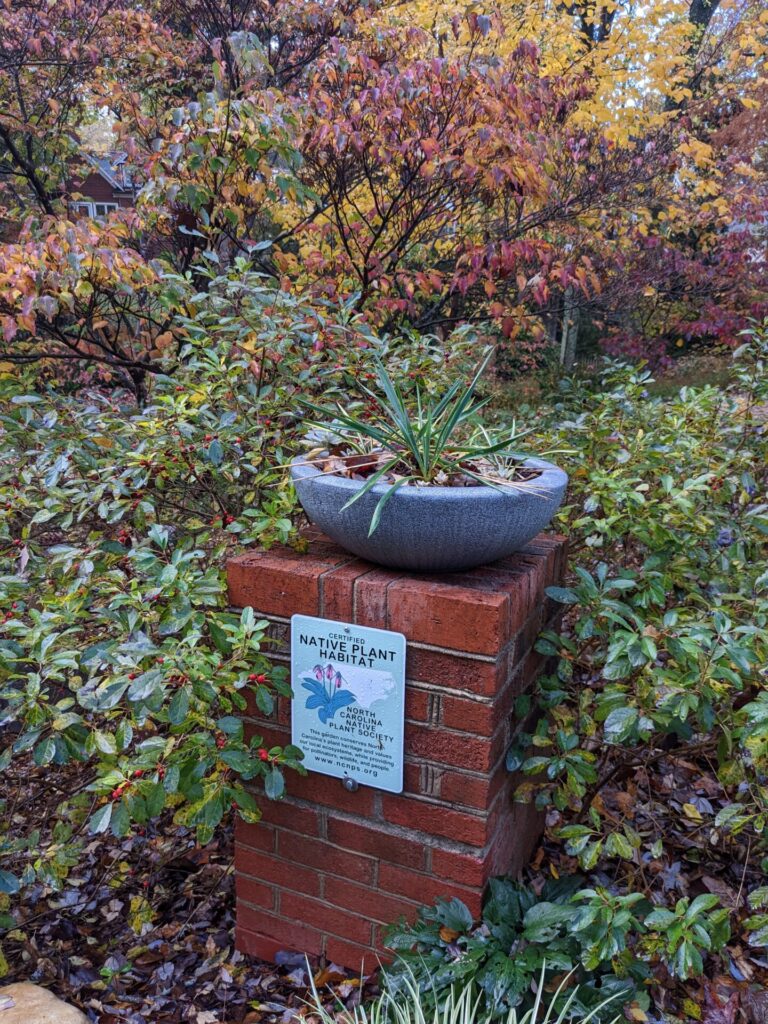
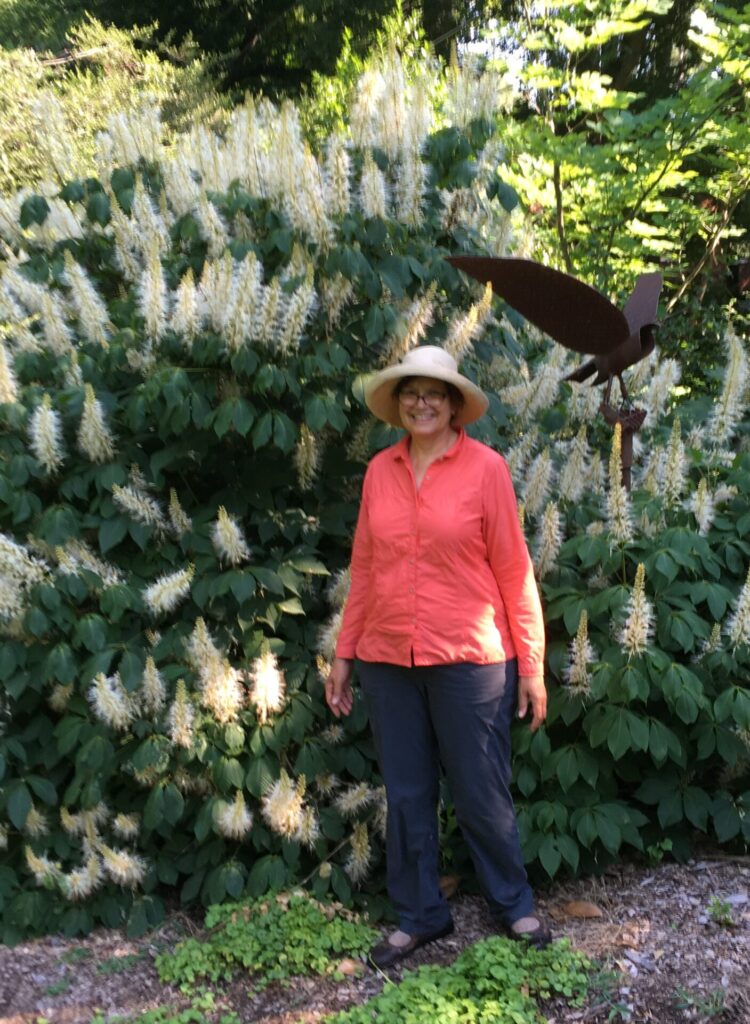

Paula Gross, M.S., has spent her career connecting plants and people through education. As the former associate director of the University of North Carolina at Charlotte Botanical Gardens, she co-lead the growth of the gardens and greenhouses with Dr. Larry Mellichamp for nearly two decades and is co-author of The Southeast Native Plants Primer and Bizarre Botanicals. Her deep belief that the human-as-part-of-Nature connections are vital for the health of both individuals and planet is what inspires her to write, teach, and consult on a wide range of botanical and horticultural topics.
Editor’s note: For a video on how North Carolina State University changed its stormwater policy see A Watershed Moment.
